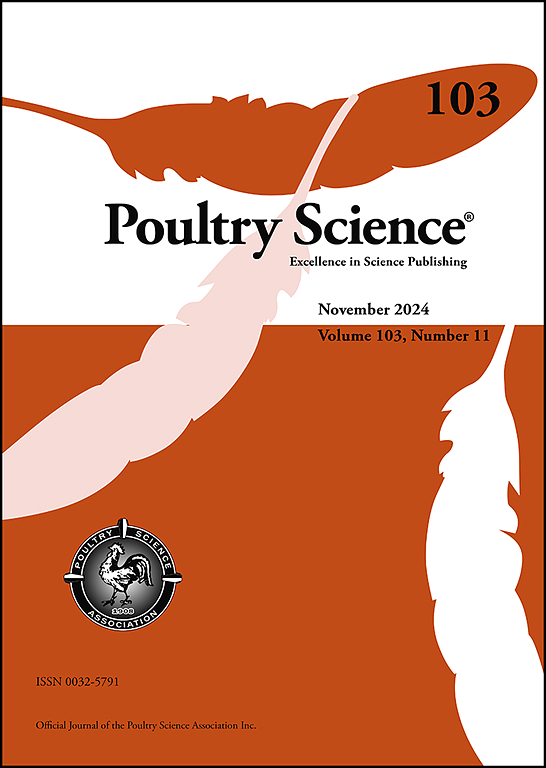Efficacy of a killed Salmonella Enterica serovar Typhimurium bacterin vaccine administration in layer birds challenged with heterologous Salmonella Enterica serovar Enteritidis
IF 3.8
1区 农林科学
Q1 AGRICULTURE, DAIRY & ANIMAL SCIENCE
引用次数: 0
Abstract
In this study, we evaluated the efficacy of administering a killed Salmonella enterica ser. Typhimurium bacterin (ST) vaccine with an adjuvant intramuscularly on humoral immunity, cellular immunity, and SE load reduction in layers. The ST vaccine was prepared with 97% S. Typhimurium and an adjuvant of 3% Immune Plus® with preservatives. Eighty 14-week-old Salmonella-free Hy-Line W-36 pullets were randomly allocated into two groups: unvaccinated control and ST vaccinated, with 40 birds per group. Birds were immunized intramuscularly with 500 µL (Endovac) vaccine at week 17 and a booster dose at week 19. At 27 weeks of age, both groups were challenged with 5 × 108 CFU/mL of nalidixic acid-resistant Salmonella enterica ser. Enteritidis. At 22, 23, and 24 weeks of age, ST-vaccinated birds showed higher serum anti-Salmonella IgY levels than the control group by 186%, 202% (P < 0.05), and 2700% (P > 0.05), respectively. At 28 weeks of age, vaccinated birds had 8.3% lower levels (P > 0.05) of anti-Salmonella IgA in bile and 240% greater levels (P < 0.05) of anti-Salmonella IgY in serum compared to control group. At 28 weeks of age, splenocytes from the ST-vaccinated birds had increased antigen-specific T-lymphocyte proliferation (P > 0.05). There were no significant differences in CD4+/CD8+-T-cell ratios, IL-10, IL-4, IL-1β, IFNγ mRNA levels in the spleen and cecal tonsil between vaccinated birds compared to control. However, the vaccine did not reduce the Salmonella Enteritidis load in ceca, spleen, and liver. It can be concluded that the intramuscular administration of the killed ST vaccine with the adjuvant Immune Plus can increase serum antibody titers and induce a humoral immune response specific to Salmonella. However, the increase in serum antibody titers were not successful in reducing the Salmonella load in ceca, spleen, and liver.
在这项研究中,我们评估了肌肉注射带有佐剂的肠炎沙门氏菌嗜血杆菌(ST)致死疫苗对体液免疫、细胞免疫和减少蛋鸡 SE 负荷的效果。我们评估了肌肉注射带有佐剂的杀灭鼠伤寒沙门氏菌菌素(ST)疫苗对体液免疫、细胞免疫和减少蛋鸡 SE 负荷的效果。ST 疫苗由 97% 的鼠伤寒杆菌和含防腐剂的 3% Immune Plus® 佐剂制备而成。将 80 只 14 周龄无沙门氏菌的 Hy-Line W-36 小母鸡随机分为两组:未接种对照组和接种 ST 疫苗组,每组 40 只。在第 17 周时用 500 µL (Endovac) 疫苗进行肌肉注射,并在第 19 周时加强免疫。在 27 周龄时,两组均接受 5 × 108 CFU/mL 抗萘啶酸肠炎沙门氏菌(Salmonella enterica ser.肠炎沙门氏菌。22周龄、23周龄和24周龄时,接种ST疫苗的鸡血清抗沙门氏菌IgY水平分别比对照组高出186%、202%(P< 0.05)和2700%(P> 0.05)。28 周龄时,与对照组相比,接种组鸡胆汁中抗沙门氏菌 IgA 含量降低 8.3% (P > 0.05),血清中抗沙门氏菌 IgY 含量增加 240% (P < 0.05)。28 周龄时,接种 ST 疫苗的禽类脾细胞的抗原特异性 T 淋巴细胞增殖增加(P >;0.05)。与对照组相比,接种疫苗的鸡脾脏和盲肠扁桃体中 CD4+/CD8+-T 细胞比率、IL-10、IL-4、IL-1β、IFNγ mRNA 水平无明显差异。然而,疫苗并没有降低肠炎沙门氏菌在盲肠、脾脏和肝脏中的含量。由此可以得出结论,肌肉注射含有免疫增强剂佐剂的 ST 死毒疫苗可提高血清抗体滴度,诱导针对沙门氏菌的特异性体液免疫反应。然而,血清抗体滴度的增加并不能成功减少盲肠、脾脏和肝脏中的沙门氏菌量。
本文章由计算机程序翻译,如有差异,请以英文原文为准。
求助全文
约1分钟内获得全文
求助全文
来源期刊

Poultry Science
农林科学-奶制品与动物科学
CiteScore
7.60
自引率
15.90%
发文量
0
审稿时长
94 days
期刊介绍:
First self-published in 1921, Poultry Science is an internationally renowned monthly journal, known as the authoritative source for a broad range of poultry information and high-caliber research. The journal plays a pivotal role in the dissemination of preeminent poultry-related knowledge across all disciplines. As of January 2020, Poultry Science will become an Open Access journal with no subscription charges, meaning authors who publish here can make their research immediately, permanently, and freely accessible worldwide while retaining copyright to their work. Papers submitted for publication after October 1, 2019 will be published as Open Access papers.
An international journal, Poultry Science publishes original papers, research notes, symposium papers, and reviews of basic science as applied to poultry. This authoritative source of poultry information is consistently ranked by ISI Impact Factor as one of the top 10 agriculture, dairy and animal science journals to deliver high-caliber research. Currently it is the highest-ranked (by Impact Factor and Eigenfactor) journal dedicated to publishing poultry research. Subject areas include breeding, genetics, education, production, management, environment, health, behavior, welfare, immunology, molecular biology, metabolism, nutrition, physiology, reproduction, processing, and products.
 求助内容:
求助内容: 应助结果提醒方式:
应助结果提醒方式:


